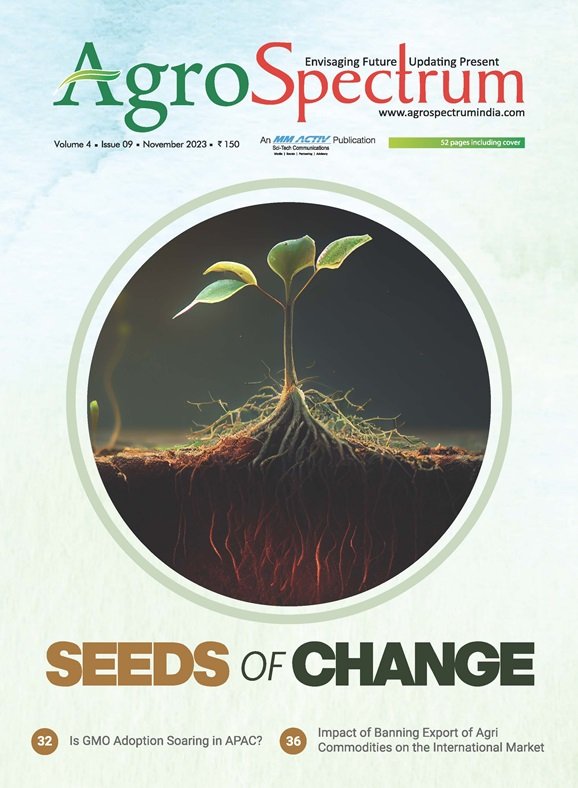“Strengthening of IPR, a scientific regulatory system, market-based pricing and policy harmonisation is crucial for seed industry”
In a conversation with AgroSpectrum, Rajendra Barwale, Chairman, Mahyco, discusses key developments and challenges of this sector. Edited excerpts:
As of 2023, the Indian seed market is valued at $3,914.36 million and is projected to grow at a compound annual growth rate (CAGR) of 7.41 per cent by 2029. Initial Public Offerings (IPOs) from the seed business, which has recently captured the interest of investors, are something that Indian investors are eagerly anticipating. Foreign Direct Investment for the development and production of seeds and planting materials is allowed by the government. Leading seed firms are combining cutting-edge digital technology, lending a further boost to the market to mitigate the effects of pests, climate, and other external factors on farming. The agricultural sector is poised for a prosperous future because of the convergence of data science, artificial intelligence tools, cutting-edge phenomic analysis, and genetic sequencing. In a conversation with AgroSpectrum, Rajendra Barwale, Chairman, Mahyco, discusses key developments and challenges of this sector. Edited excerpts:
How is technology helping the seed sector thrive?
Every facet of our lives is undergoing a rapid transformation as a result of the application of technology. Not one exception to this pattern may be seen in the agriculture and seed industry. Seed firms can develop novel, efficient, and speedier technologies for the production of new genetics that can be supplied through seeds due to the growing knowledge base of biological sciences mixed with information technology. Agriculture is facing numerous difficulties due to the depletion of natural resources, the influence of rapid climate change, and the growing demand for the development of instruments for sustainable agriculture. We believe that the utilisation of the aforementioned instruments has the potential to offer long-term solutions for overcoming these issues and assisting in the fulfilment of the agri expectations. For instance, the application of technology could help reduce the amount of fresh water and chemical fertiliser used for farming.
How has FDI in seed manufacturing strengthened the seed industry in the country?
Since the late 1980s and the early 1990s, when a new seed policy was introduced, foreign direct investment (FDI) in the seed business has been permitted in India. The liberalisation of FDI was a significant factor in the acceleration of the development of the Indian seed industry, as well as the introduction of innovation and technology. In the long run, it is essential to cultivate such an environment for the seed industry to provide farmers with improved goods and technology, hence strengthening the overall competitiveness of Indian agriculture and improving the quality and productivity of our crops.
What role can the government play in supporting the seed industry?
The development of a thriving seed industry is essential to the expansion of agriculture, and it has been an essential factor in the enhancement of agricultural yield across the globe over many years. For instance, the green revolution in India, which resulted in a surplus of food from ‘ship to mouth’ during the early years of independence, had its origins in the enhanced varieties of wheat and rice that we grew by utilising the genetics of wheat and rice that were brought in from Mexico and International Rice Research Institute (IRRI), Manila, respectively. In India and around the world, we can provide several examples of such shifts that have been brought about by the science of plant breeding. However, compared with other agriculturally developed countries, the size of the seed sector in terms of its potential is relatively quite modest at the moment. This presents us with a significant possibility for future expansion. As a result of the fact that the expansion of the seed industry would have a multiplier effect on the development of the agriculture sector, the contribution of the Government of India in the expansion of the seed industry would be beneficial to all of the stakeholders in Indian agriculture, most particularly our farmers.
What are the major challenges that are hampering the growth of this sector?
The ‘low amount of money’ we invest in research and development (R&D) is the most significant element that is hampering the expansion of the seed industry. Less than four per cent of our seed industry’s yearly income is anticipated to be invested in R&D, which is far lower than the 8 to 10 per cent seen in agriculturally developed nations. Since we have the greatest population to feed and our crop productivity is much lower than the average crop productivity around the globe for the majority of crops, we ought to be investing a great deal more in R&D. To promote investments in R&D, the sector requires heavy policy assistance. The most important areas include the strengthening of intellectual property rights, the promotion of a regulatory system that is founded on science and is predictable, the encouragement of market-based pricing, and the guaranteeing of policy harmonisation not just between the central government and the states, but also on a worldwide scale.
To read more click on: https://agrospectrumindia.com/e-magazine
In a conversation with AgroSpectrum, Rajendra Barwale,


